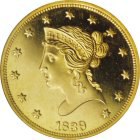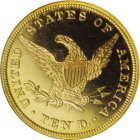 This was an amazing opportunity for the advanced collector, the connoisseur of early American gold coinage, or the numismatist who appreciates the combination of quality and rarity. This masterpiece is the finest of just three proofs known, and one of just two examples available to collectors. Three additional proofs are known for the 1838 eagle, bringing the total population to six coins for this first design type. One of each date is held by the Smithsonian Institution, and the other four are available to collectors. This specimen is the finest of all six known proofs of this first Liberty Head eagle design.
This was an amazing opportunity for the advanced collector, the connoisseur of early American gold coinage, or the numismatist who appreciates the combination of quality and rarity. This masterpiece is the finest of just three proofs known, and one of just two examples available to collectors. Three additional proofs are known for the 1838 eagle, bringing the total population to six coins for this first design type. One of each date is held by the Smithsonian Institution, and the other four are available to collectors. This specimen is the finest of all six known proofs of this first Liberty Head eagle design.
In the Eliasberg catalog, Dave Bowers wrote: "The 1839 Large Letters or Type of 1838 eagle has traditionally been one of the most desired issues in the series. Specimens are very elusive in high grades, and in proof grade this piece ranks as one of the most important rarities in the field of American numismatics. A marvelous opportunity for the specialist."
 Walter Breen wrote in his Encyclopedia of United States and Colonial Proof Coins: "Large Letters, type of 1838. Date low, to left, many die file marks near rev. border. (1) Smithsonian, from Mint collection. (2) Parmelee: 1097 to Chapman, Jenks: 5735, John H. Clapp, now in Eliasberg collection. No rumor of a third specimen." A decade later, the same author mentioned the third specimen in his Complete Encyclopedia: "East European pvt. coll., 1981, Mark Emory for NERCG, in a proof set including $2 1/2 and $5."
Walter Breen wrote in his Encyclopedia of United States and Colonial Proof Coins: "Large Letters, type of 1838. Date low, to left, many die file marks near rev. border. (1) Smithsonian, from Mint collection. (2) Parmelee: 1097 to Chapman, Jenks: 5735, John H. Clapp, now in Eliasberg collection. No rumor of a third specimen." A decade later, the same author mentioned the third specimen in his Complete Encyclopedia: "East European pvt. coll., 1981, Mark Emory for NERCG, in a proof set including $2 1/2 and $5."
In United States Gold Coins, An Analysis of Auction Records, David Akers commented briefly: "There are only two known proofs, one in the Smithsonian Institution and the other in the Eliasberg Collection." His 1980 reference was published just a year before the third example was discovered. Recently, Jeff Garrett and Ron Guth wrote Encyclopedia of U.S. Gold Coins, 1795-1933, published in 2006. Every U.S. gold issue, business strikes and proofs, was given a third page of space. For this proof issue they wrote: "The Proof 1839, Type of 1838 eagle is an exceedingly rare coin of which only three examples are known. The first is the PF-66 deep cameo in the Smithsonian Institution, obtained in the year of issue as were virtually all of the Proof gold coins in that collecti, the only exception being additions from the Lilly Collection. The second example and the finest of the three is the Eliasberg Proof coin that later sold as an NGC PF-67 ultra cameo in a 1999 auction for $690,000. The third examples is a PF-61 listed in the PCGS Population Report, a coin that reportedly came out of Eastern Europe in 1981, along with a Proof quarter eagle and half eagle."
According to the Mint Act of 1792, the ten dollar gold piece was declared the unit of all gold coinage and was named the eagle. Smaller gold denomination coins were called the half eagle and the quarter eagle.
Once gold coinage actually began in 1795, the eagle remained in use only for a decade, being discontinued in 1804 in favor of the half eagle. Much of this had to do with the increasing price of gold and the extremely limited production of gold coins by the Philadelphia Mint. Gold value eventually exceeded face value for all of the gold coins.
For many years, the half eagle was the denomination of choice among those who deposited gold with the mint. Few depositors requested eagles and even fewer asked for quarter eagles. In 1804, President Thomas Jefferson halted production of both the eagle and the silver dollar. It was another 30 years before the Philadelphia Mint coined another 10 dollar piece, in 1834. The "1834" eagles were actually dated 1804, were produced for inclusion in special presentation sets to be given to foreign monarchs such as the King of Siam.
Finally, full scale production of gold eagles resumed in 1838 by order of the Secretary of the Treasury, a few years after the standard weight for gold coinage was reduced to levels that brought gold value and face value back in line. With an internal supply of gold discovered in Georgia and the Carolinas a few years earlier, the necessity of a larger gold coin became evident.
Christian Gobrecht created the Liberty Head design, the first style used only in 1838 and 1839, before slight modification. The second head style remained in use from 1839 through 1907. In the earliest years of this design, few proofs were coined, usually only upon request by an occasional collector, or by government authority for presentation purposes. Today, less than 40 proof eagles are known for the entire two decades from 1838 to 1857, and this total includes a dozen such pieces in the Smithsonian Institution.
The Liberty Head design was created by Christian Gobrecht who is best known for his silver dollar design of 1836. During his brief tenure at the Mint's engraving shop, Gobrecht also created the Braided Hair design for half cents and large cents, as well as similar designs for several pattern issues. The obverse has a bust of Liberty facing to the left, with her hair bound into a triple bun at the back, and held in place by a beaded cord. A coronet or crown in her hair is inscribed with the word LIBERTY. The bust truncation is smoothly curved, forming a sharp point at the back. Thirteen stars are placed just inside the obverse border, beginning at 7 o'clock, clockwise to 5 o'clock. The 1839 date is placed below the bust. For the reverse design, Gobrecht chose an eagle with its wings reaching skyward, gazing to the West. The eagle holds an olive branch in its dexter claw and three arrows in its sinister claw. A shield covers the eagle's breast, composed of six vertical two-line stripes and nine horizontal crossbars. The statutory legend UNITED STATES OF AMERICA follows the border clockwise from 7:30 to 4:30 with the denomination abbreviated TEN D. below.
Over the years, this issue has become known as the "1839 Large Letters" eagle. While there is a slight difference in the size of the reverse lettering, obvious when coins of each type are side-by-side, this difference is not obvious when examining one coin or the other. The difference in the appearance of the obverse is much easier to discern when looking at an individual coin. The date is farther left on the Type of 1838, the bust truncation is much more noticeably curved, and the hair over the ear has an entirely different treatment. For these reasons, we refer to this piece as the 1839 Type of 1838 eagle.
The digits 1 and 9 show evidence of recutting, visible at the serif and top of the upright of the 1, and along the outer right side of the 9. A short diagonal die line joins the ball of the digit 3 to the border below the right side of the 8. Short raised die lines extend up from the hair below the right serif of T and the left serif of Y. The reverse has myriad fine die lines, along with a series of heavy die file marks between the border and lettering, especially visible over STATES OF, ERICA, and below N D.
A numismatic masterpiece, this coin is easily the finest known 1839 proof eagle, and far beyond the quality of the only other example available to collectors. All of the individual die characteristics on both sides are intricately detailed, with the sole exception of stars 7 through 10, each lacking most or all of their radial lines. Struck in brilliant yellow gold, the fields on both sides are exceptionally deep with fully mirrors. The devices are highly lustrous with complete mint frost. This is an amazing cameo proof with extraordinary aesthetic appeal. A few insignificant flakes and lint marks are visible on each side, along with light clash marks.
1. PR61 PCGS. Recorded in the PCGS Population Report. This is the piece from the European private collection mentioned by Breen in his Complete Encyclopedia. It was purchased by Marc Emory in Europe in 1981 for New England Rare Coin Galleries as part of a three piece gold proof set. No further details regarding this coin are known.
2. PR66 Deep Cameo. U.S. Mint; National Numismatic Cabinet; Smithsonian Institution. Illustrated in Encyclopedia of U.S. Gold Coins.
© 2006 Heritage Galleries. Used with permission of Steve Ivy and Heritage Galleries.